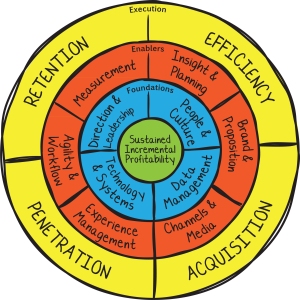Designing and executing a customer-centric business model requires end to end organisational alignment. Customer-centric capability development cannot take place in isolation to the rest of the business. The customer-centric journey requires a clear quantified understanding of current organisational capability across all 14 capability areas of the SCHEMA Customer Management framework in the centre of the REAP Customer-Centric Blueprint below. As important as an understanding of current customer management capability is, so to is an understanding of the capability to which the organisation aspires.
Over the next 14 weeks I will address each capability area (1 per week), sharing with you the Transformation Intent to which your organisation should commit, as well as ‘What Good Looks Like’ for those organisations that have achieved a level of maturity in the respective capability area.
This week we are dealing with Direction & Leadership which is one of the four Foundational capability areas represented. The Foundations layer includes the fundamental building blocks that support or limit your transformation ability. These capability areas require broad-based input and alignment, without which the operationalization of a customer-centric business model is almost impossible.
Transformation Intent – Direction and Leadership
“The keystone of an effective customer-centric foundation is an innovative, integrated, customer-centric strategy that is driven by leaders passionate about, and committed to, transforming the organisation, while delivering sustainable and superior business performance. This focused direction will enable you to demonstrate the compelling business case for customer-centricity through meaningful customer value metrics and realistic customer planning. Change management, in turn, supports you to develop an intrinsic customer-centric culture that activates the transformation required.”
What Good Looks Like – Direction and Leadership
•The organisation’s Corporate Strategy provides explicit content that informs and directs Customer (Management) Strategy as well as setting the context for treating it as a Business ‘System’ that needs managing.
•There is alignment on the required future state of Customer Management, what external factors will impact it and the key strategies that will be deployed to deliver it.
•A high level business case has been developed to justify the Customer (Management) Strategy and explain the value of investing and reporting the ‘Customer Financial Performance’ of the organisation.
•The organisation’s historical ability to deliver, and current readiness for, change has been realistically assessed. Drivers and barriers have been identified and planning of improvement activity takes this fully into account.
•Customer Management is clearly and formally owned by a skilled and enthusiastic leader who is supported by the commitment of the executive team to the organisation’s focus on customers.
See my book “The Customer-Centric Blueprint’ – http://amzn.to/ZILg4y





